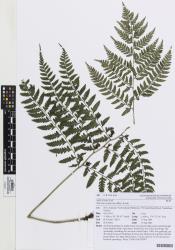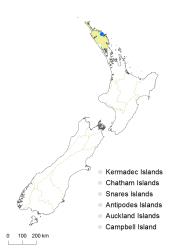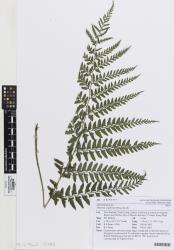- ≡ Asplenium otophorum Miq., Ann. Mus. Bot. Lugduno-Batavi 3, 3: 175 (1867)
In New Zealand Athyrium otophorum has a short, erect rhizome giving rise to fronds up to 550 mm long. It has yellow-brown stipes up to 220 mm long, bearing linear or narrowly ovate, blackish-brown scales proximally. The laminae are 2-pinnate to 2-pinnate-pinnatifid, ovate to broadly ovate, up to 350 mm long and 350 mm wide, and glabrous or with occasional narrow scales on the rachis. The primary pinnae are up to 200 mm long and 60 mm wide. The secondary pinnae are up to 40 mm long and 12 mm wide, shortly-stalked, lobed or deeply pinnatifid, with the basal acroscopic lobe longer than the others. The indusia are entire and elongated along the veins and up to 2 mm long.
North Island: Northland.
Altitudinal range: 10 m.
Known from one locality in Kerikeri.
Occurs naturally in China, Korea, Japan, and Taiwan.
Recorded as sporadically self-sown along the edges of paths and among ferns in a cultivated area at Kerikeri. Self-sown sporelings have also been recorded in a shade-house at Helensville.
Heenan et al. (2004, p. 802). Voucher AK 283997, 2003.






